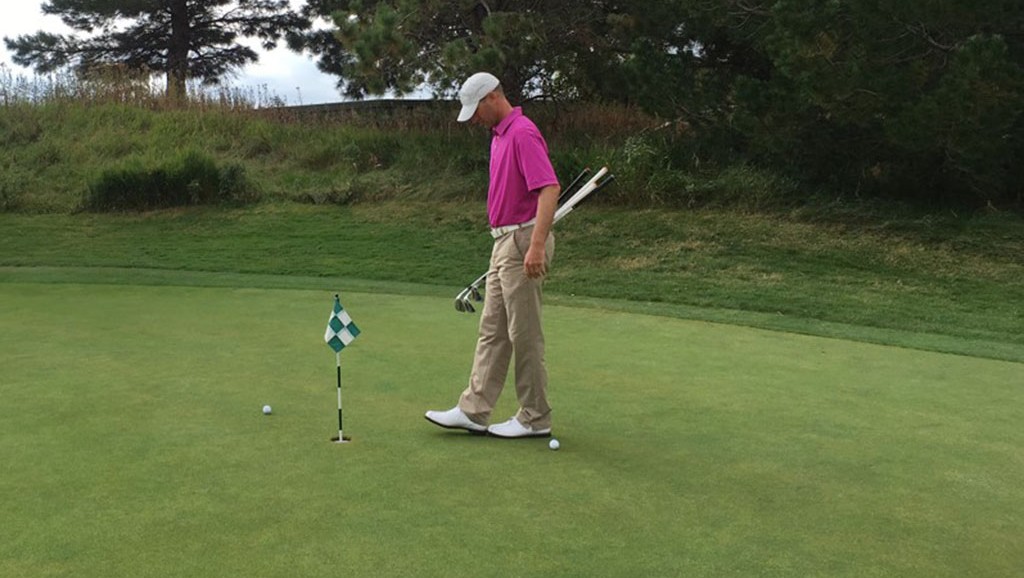Instruction
Take the Test: How bad are your bad shots?

Taking a mulligan, breakfast ball or redo shouldn’t be a part of your game. Over time, these types of “freebies” weaken your ability to recover mentally and physically from whatever circumstance comes your way. Bad shots are a part of the game — how you react and recover after hitting one can make or break your round.
For you juniors interested in playing college golf, next time you hit a bad shot with a college coach watching you, think about the following: college coaches already know what you shoot. They know your scores. What they don’t know though is how you act around your fellow competitors. They don’t know how you act to your parents, and they don’t know how you act after you hit a bad shot. You can bet, when a college coach comes out to watch you play, that’s what they’re looking at. Among other things they want to see how you react and recover after hitting a bad shot. This game is all about your bad shot!
Game: Bad-Ball Distance
- Gear needed: Clubs you chip with and two golf balls
- Time needed: 15-25 minutes
Rules: Place two balls just off of the green and chip them as close to the hole as possible. Of those two shots, step off the distance of the ball that is farthest away from the hole — this is your “bad ball” — and log it in a practice journal. Not that you want to dwell on your bad shots, but by playing this game will help you focus on every shot you hit instead of just mindlessly hitting short game shots.
Proceed to do this for a total of nine times and add up the TOTAL number of feet you had left over for all nine bad balls. Then try to beat (lower) that number next time you practice. You can even use the “scorecard” below to help get you started with different shots/clubs.
To see more games like this, you can visit our interactive practice website www.golfscrimmages.com or our 230-page book by the same title Golf Scrimmages: Realistic Practice Games Under Pressure.
HOLE CLUB/SHOT WORST BALL DISTANCE
1 Sand Wedge
2 Downhill Lie
3 Deep Rough
4 7-iron
5 Against Collar
6 Short-sided
7 Open-face Chip
8 Uphill Lie
9 9-iron
TOTAL DISTANCE: _______________
- LIKE70
- LEGIT13
- WOW2
- LOL0
- IDHT0
- FLOP3
- OB1
- SHANK7
Instruction
Clement: Laid-off or perfect fade? Across-the-line or perfect draw?

Some call the image on the left laid off, but if you are hitting a fade, this could be a perfect backswing for it! Same for across the line for a draw! Stop racking your brain with perceived mistakes and simply match backswing to shot shape!
- LIKE0
- LEGIT0
- WOW0
- LOL0
- IDHT0
- FLOP0
- OB0
- SHANK1
Instruction
The Wedge Guy: The easiest-to-learn golf basic

My golf learning began with this simple fact – if you don’t have a fundamentally sound hold on the golf club, it is practically impossible for your body to execute a fundamentally sound golf swing. I’m still a big believer that the golf swing is much easier to execute if you begin with the proper hold on the club.
As you might imagine, I come into contact with hundreds of golfers of all skill levels. And it is very rare to see a good player with a bad hold on the golf club. There are some exceptions, for sure, but they are very few and very far between, and they typically have beat so many balls with their poor grip that they’ve found a way to work around it.
The reality of biophysics is that the body moves only in certain ways – and the particulars of the way you hold the golf club can totally prevent a sound swing motion that allows the club to release properly through the impact zone. The wonderful thing is that anyone can learn how to put a fundamentally sound hold on the golf club, and you can practice it anywhere your hands are not otherwise engaged, like watching TV or just sitting and relaxing.
Whether you prefer an overlap, interlock or full-finger (not baseball!) grip on the club, the same fundamentals apply. Here are the major grip faults I see most often, in the order of the frequency:
Mis-aligned hands
By this I mean that the palms of the two hands are not parallel to each other. Too many golfers have a weak left hand and strong right, or vice versa. The easiest way to learn how to hold the club with your palms aligned properly is to grip a plain wooden ruler or yardstick. It forces the hands to align properly and shows you how that feels. If you grip and re-grip a yardstick several times, then grip a club, you’ll see that the learning curve is almost immediate.
The position of the grip in the upper/left hand
I also observe many golfers who have the butt of the grip too far into the heel pad of the upper hand (the left hand for right-handed players). It’s amazing how much easier it is to release the club through the ball if even 1/4-1/2″ of the butt is beyond the left heel pad. Try this yourself to see what I mean. Swing the club freely with just your left hand and notice the difference in its release from when you hold it at the end of the grip, versus gripping down even a half inch.
To help you really understand how this works, go to the range and hit shots with your five-iron gripped down a full inch to make the club the same length as your seven-iron. You will probably see an amazing shot shape difference, and likely not see as much distance loss as you would expect.
Too much lower (right) hand on the club
It seems like almost all golfers of 8-10 handicap or higher have the club too far into the palm of the lower hand, because that feels “good” if you are trying to control the path of the clubhead to the ball. But the golf swing is not an effort to hit at the ball – it is a swing of the club. The proper hold on the club has the grip underneath the pad at the base of the fingers. This will likely feel “weak” to you — like you cannot control the club like that. EXACTLY. You should not be trying to control the club with your lower/master hand.
Gripping too tightly
Nearly all golfers hold the club too tightly, which tenses up the forearms and prevents a proper release of the club through impact. In order for the club to move back and through properly, you must feel that the club is controlled by the last three fingers of the upper hand, and the middle two fingers of the lower hand. If you engage your thumbs and forefingers in “holding” the club, the result will almost always be a grip that is too tight. Try this for yourself. Hold the club in your upper hand only, and squeeze firmly with just the last three fingers, with the forefinger and thumb off the club entirely. You have good control, but your forearms are not tense. Then begin to squeeze down with your thumb and forefinger and observe the tensing of the entire forearm. This is the way we are made, so the key to preventing tenseness in the arms is to hold the club very lightly with the “pinchers” — the thumbs and forefingers.
So, those are what I believe are the four fundamentals of a good grip. Anyone can learn them in their home or office very quickly. There is no easier way to improve your ball striking consistency and add distance than giving more attention to the way you hold the golf club.
More from the Wedge Guy
- The Wedge Guy: Golf mastery begins with your wedge game
- The Wedge Guy: Why golf is 20 times harder than brain surgery
- The Wedge Guy: Musings on the golf ball rollback
- LIKE88
- LEGIT14
- WOW6
- LOL1
- IDHT0
- FLOP4
- OB1
- SHANK8
Instruction
Clement: Stop ripping off your swing with this drill!

Not the dreaded headcover under the armpit drill! As if your body is defective and can’t function by itself! Have you seen how incredible the human machine is with all the incredible feats of agility all kinds of athletes are accomplishing? You think your body is so defective (the good Lord is laughing his head off at you) that it needs a headcover tucked under the armpit so you can swing like T-Rex?
- LIKE0
- LEGIT3
- WOW2
- LOL0
- IDHT0
- FLOP0
- OB0
- SHANK2
-

 19th Hole1 week ago
19th Hole1 week agoJustin Thomas on the equipment choice of Scottie Scheffler that he thinks is ‘weird’
-

 19th Hole1 week ago
19th Hole1 week ago‘Absolutely crazy’ – Major champ lays into Patrick Cantlay over his decision on final hole of RBC Heritage
-

 19th Hole3 weeks ago
19th Hole3 weeks agoTwo star names reportedly blanked Jon Rahm all week at the Masters
-

 19th Hole2 weeks ago
19th Hole2 weeks agoReport: LIV Golf identifies latest star name they hope to sign to breakaway tour
-

 19th Hole2 weeks ago
19th Hole2 weeks agoNeal Shipley presser ends in awkward fashion after reporter claims Tiger handed him note on 8th fairway
-

 19th Hole2 weeks ago
19th Hole2 weeks agoBrandel Chamblee has ‘no doubt’ who started the McIlroy/LIV rumor and why
-

 Equipment3 weeks ago
Equipment3 weeks agoWhat we know about Bryson DeChambeau’s 3D-printed Avoda irons
-

 19th Hole6 days ago
19th Hole6 days agoLET pro gives detailed financial breakdown of first week on tour…and the net result may shock you


















kenkennykenneth
Sep 23, 2016 at 3:01 pm
For those who want to improve their game, this sounds like meat and potatoes. Measuring is, after all, the basis of how we compare round to round. Why wouldn’t we use that tool to practice?
larrybud
Sep 23, 2016 at 12:58 pm
A test is no good without grades, or all we getting a trophy for playing the game?